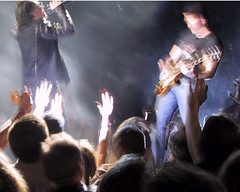U2 Versus The Loudness Wars
Having recently moved into an office near the site of the proposed U2 tower, I now pass through an area well-endowed with U2 graffiti as part of my daily commute. Today another mention of U2 caught my eye, but this time in the title of an article dealing with the loudness wars…
Where The Streets Sound The Same
The loudness wars really kicked off to another level in the 1990s, but their origins date back to the era of jukebox players – if your record came on directly after a louder record, it just wouldn’t be perceived to sound as good. This is basically down to a psychoacoustic effect – louder being perceived to sound better – but in reality, if you just turn the volume up then the ‘quieter’ record would probably actually have the better sound quality.
The age of jukeboxes is long since over, but radio was still a vital source of exposure for artists in the 90s, and everybody wanted to make sure they had the loudest record in the cue list.
Despite the fact that radio broadcasts are compressed to level match the songs anyway, many producers got caught up in a race to the bottom when it came to making their products as loud as possible. This was enabled by digital technology which allowed extreme compression to be applied to waveforms; although it was certainly louder, the sound quality suffered as a result.
Basically, songs were having their dynamic range surgically removed – the variation between loud and quiet passages was attenuated drastically. This leads to music that is lacking a lot of essential dynamism, and can actually be quite difficult to listen to for any length of time.
U2 Through The Decades
Ian Shepherd is a mastering engineer who has been campaigning for increased dynamic range in recordings for many years now. This video below uses a series of U2 songs from the 80s to the present day to illustrate the trends in production that dominated pop/rock over the past few decades, and the detrimental impact it can have on sound quality:
Fortunately, if U2’s latest single is anything to go by, it looks like the message is getting through, and perhaps the tide in the loudness wars has finally turned.
In fact, as Ian points out, the reasons that originally prompted louder recordings are no longer valid (if indeed they ever were), and in the digital age excessively loud recordings can actually be a disadvantage. With many people listening to their mp3 collection on shuffle with some form of sound check enabled, the louder recordings are likely to be ‘normalised’ down to a lower perceived loudness level – and also then suffering from actual lower dynamic range levels to boot.
Sound Check Levels The Playing Field
So, as we have sound check as an obligatory feature on iTunes Radio (and similar technology applied to most other Internet radio stations) the production focus should once more return to creating recordings that have greater dynamic range, and absolute loudness should be less of a priority. Now that Internet bandwidth can cope with higher definition audio streams, here’s hoping that consumers will embrace sound quality as a key criterion in their listening experience, and vote with their ears. Judging by these latest trends, and also Neil Young’s recent announcement of a new high-quality audio player, it looks like there certainly is a market for a better sounding future…
